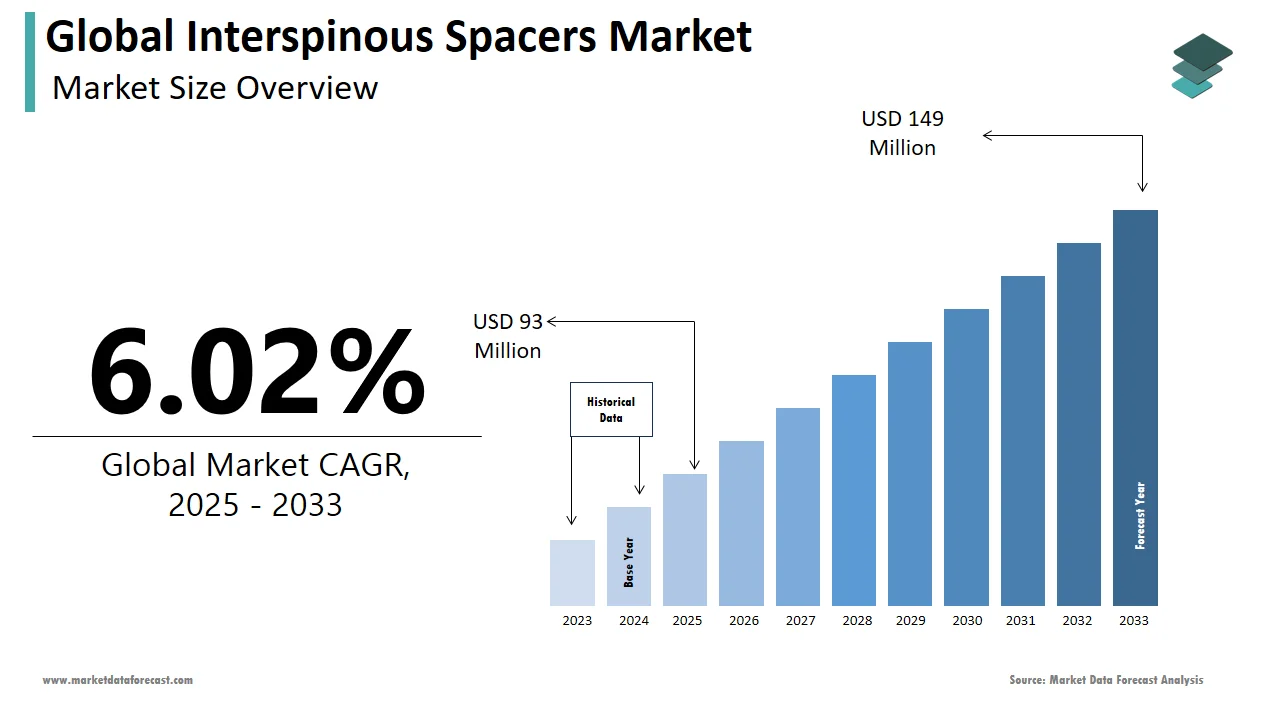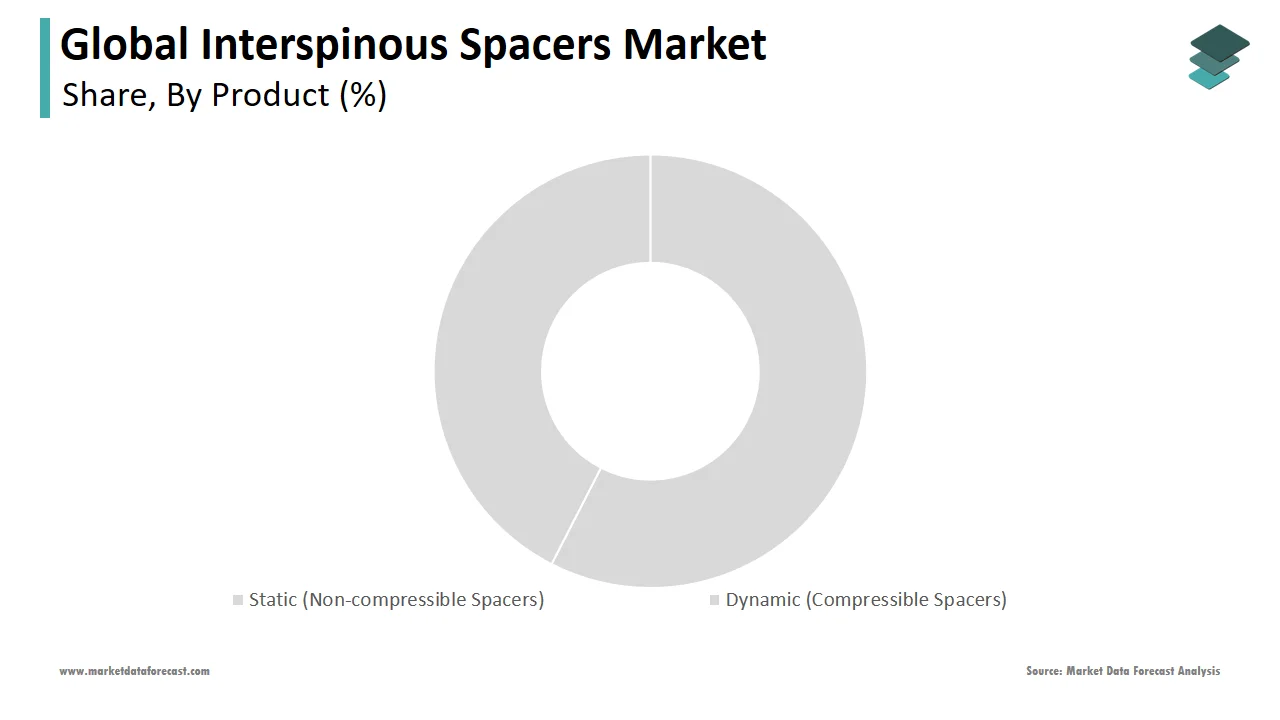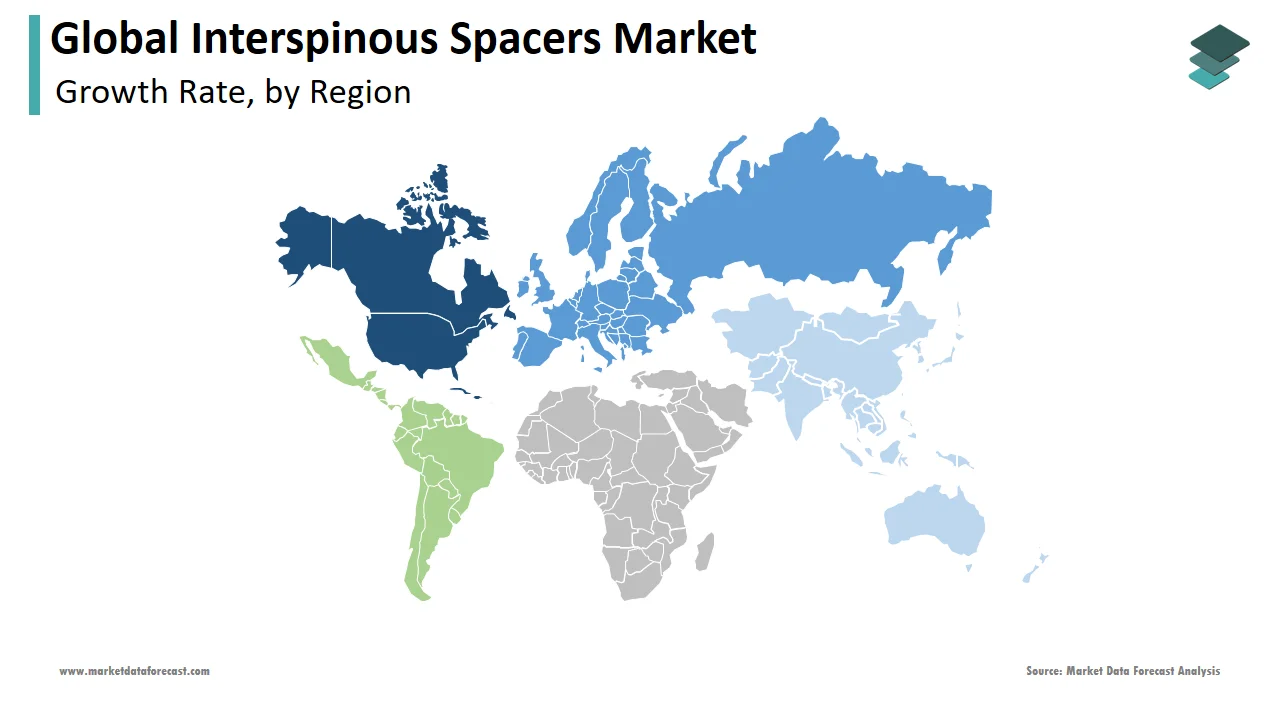Global Interspinous Spacers Market Size, Share, Trends & Growth Forecast Report By Product, Application, End-User and Region (North America, Europe, Asia-Pacific, Latin America, Middle East and Africa), Industry Analysis From 2025 To 2033.
Global Interspinous Spacers Market Size
The size of the global interspinous spacers market was worth USD 88 million in 2024. The global market is anticipated to grow at a CAGR of 6.02% from 2025 to 2033 and be worth USD 149 million by 2033 from USD 93 million in 2025.

The interspinous spacers are one of the devices that surgeons use to fix the spinal cord of elderly patients. Interspinous ligaments are generally thin and membranous, which connect to the adjacent spinous processes of the vertebrae, extending from the root to the apex. An interspinous spacer is implanted to open the previously narrowed spine to treat abnormalities such as spinal stenosis.
MARKET DRIVERS
The rising prevalence of spinal disorders among the population globally augments interspinous spacers market growth.
Degenerative disc or spinal stenosis, such as spinal disorders, is found to be very common in older people. The Centers for Disease Control and Prevention (CDC) stated, by 2030, the possibility of the number of people aged 65 and older would be doubled. The growing aging population suffering from osteoporosis and a considerable amount of the younger population suffering from spinal disorders are anticipated to drive the market's growth over the forecast period.The active participation of various market players in intensive R&D programs is one of the factors driving the interspinous spacers market.
The focus of companies on R&D to develop innovative solutions for spine surgeries, rising aging generations, and the high prevalence of degenerative spinal conditions are expected to have a favorable impact on market growth. In addition, growing acceptance of interspinous spacers, increasing awareness around interspinous struts, technological advancements to introduce the next generation of surgical solutions with improved safety and efficacy outcomes, along with the high demand for adoption of minimally invasive surgeries and geographic expansion of the market players through product launches and mergers are promoting the market’s growth rate.
Recent technological advances in the industry, such as 3D printing technology, have been widely used for the rapid prototyping of interspinous spacers by surgeons, allowing them to design a perfect-sized prosthesis, helping the market grow. Also, an IPD spacer doesn't require removing bone as in traditional laminectomy to create space for the spinal cord and spinal nerves, with the advantage of causing less trauma to muscles and ligaments, further increasing its adoption. Furthermore, since these procedures are minimally invasive, they require only a small skin incision in the middle of the back for the placement of small tubes between the spinous processes of the vertebra, taking only about one and a half to two hours for the entire surgery to be completed, more accessible and faster rehabilitation, preserving the movement and stability, and enabling the patient to walk home the same day of surgery is further responsible for the growing adoption of interspinous spacers, leading to the growth of the market.
MARKET RESTRAINTS
Although patients may benefit greatly from interspinous spacers implanted by a minimally invasive technique, certain risk factors are expected to restrain the market's growth. Complications associated with IPD devices, higher incidence of reoperation, and higher cost through hardware failures, causing incorrect interspinous spacer placements, leading to reoperation, which in turn causes a financial burden for patients, would be hampering the growth of the market. Moreover, the lack of trained orthopedic surgeons in significant hospitals and specialty clinics in some low-income countries, a limited number of market players, and the high cost required for spine surgery procedures are further foreseen to obstruct market growth.
REPORT COVERAGE
|
REPORT METRIC |
DETAILS |
|
Market Size Available |
2024 to 2033 |
|
Base Year |
2024 |
|
Forecast Period |
2025 to 2033 |
|
CAGR |
6.02% |
|
Segments Covered |
By Product, Application, End-User, and Region. |
|
Various Analyses Covered |
Global, Regional, and country-level analysis; Segment-Level Analysis, DROC; PESTLE Analysis; Porter’s Five Forces Analysis, Competitive Landscape; Analyst Overview of Investment Opportunities |
|
Regions Covered |
North America, Europe, APAC, Latin America, Middle East & Africa |
|
Market Leaders Profiled |
Globus Medical Inc., NuVasive Inc., Life Spine Inc., Paradigm Spine, Medtronic, Johnson & Johnson, Boston Scientific, Zimmer Biomet, Mikai S.p.A and Synthes GmbH., and Others. |
SEGMENTAL ANALYSIS
By Product Insights

Based on the product, the static interspinous spacers segment is anticipated to dominate the interspinous spacers market over the forecast period owing to the growing aging population prone to lumbar spinal stenosis, static interspinal spacers, proven to be the safest method for implanting between the spinous processes of the vertebrae, are more costly and effective than a traditional laminectomy, requiring a high-cost complicated surgery. Therefore, it is used for opening the neural foramen. On the other hand, the compressible spacers segment is expected to grow steadily owing to significant improvements in therapeutics, leading to much lower failure rates of the treatments and preventing reoperations.
By Application Insights
Based on the application, the lumbar spinal stenosis segment is anticipated to hold the dominant share of the market during the forecast period. Lumbar stenosis is higher in the aging population than in the young population. This is usually the narrowing of the spinal canal, compressing the nerves within it. An estimated 11% of the senior population suffers from lumbar spinal stenosis in the United States. On the other hand, the degenerative disc diseases segment is anticipated to showcase healthy growth during the forecast period, being one of the most misunderstood disorders requiring further treatments. Degenerative disc diseases are among the most common causes of lower back and neck pain caused by wear and tear on the spinal disc. It is also responsible for causing numbness, weakness, and burning, throbbing pain in the arms or legs. Across the world, a considerable population is suffering from degenerative disc diseases.
By End-User Insights
Based on the end-user, the hospital segment is anticipated to hold the largest market share during the forecast period owing to the many hospital orthopedic physicians. The hIn addition, the hospital segment had the expertise required to diagnose, treat, and prevent injuries and musculoskeletal disorders, including degenerative disc disorders, scoliosis, and traumatic injuries. The ASCs, on the other hand, is the fastest growing healthcare facility and is proving to be gaining patients' satisfaction with the outcome of the surgery, low cost, and quality of care they receive and also impressed with the way the facility is run, which is why the ambulatory surgical centers are also expected to grow over the forecast period.
REGIONAL ANALYSIS

The region of North America is anticipated to dominate the global interspinous spacers market over the forecast period. The domination of the North American region is attributed to factors such as rapid approvals for these devices and procedures from the USFDA, YOY growth in the number of older adults suffering from spinal stenosis, the increase in cases of lumbar spinal stenosis due to lifestyle changes in the region, and the presence of technologically advanced countries. In addition, growing healthcare expenditure in the North American region is anticipated to offer lucrative growth opportunities to the market.
The U.S. is forecasted to lead the North American region, along with Canada, due to well-developed healthcare systems, a growing number of older adults in these countries, a high prevalence of degenerative disc disorders and spinal stenosis, large sums of spending by the market players on research and development, and favorable reimbursement of interspinous spacer devices. In addition, the Centers for Disease Prevention and Control (CDC) estimated the population of 60 years and older to double by 2030, reaching about 71 million in the U.S. The growth in the aging population in the U.S. is expected the boost the demand for spine surgeries, leading to market growth in the United States.
Europe's market is anticipated to hold a substantial share of the global interspinous spacer market during the forecast period. The European market is driven by the fast approval of products, favorable regulatory scenario, and a growing population suffering from spinal disabilities.
However, the Asia-Pacific is predicted to register the fastest CAGR in the global market during the forecast period owing to the increasing geriatric population, leading to increasing cases of lumbar spine degenerative diseases in the Asia-Pacific region and growing healthcare expenditure in most of the developing countries of this region. Moreover, NIH recorded more than 200 million LSS disorders in countries like Japan and China every year. These higher incidences of degenerative disc diseases, increasing investment by major market players, and rising per capita income are reasons for the market growth in this region.
KEY MARKET PLAYERS
Companies playing a vital role in the global interspinous spacers market profiled in this report are Globus Medical Inc., NuVasive Inc., Life Spine Inc., Paradigm Spine, Medtronic, Johnson & Johnson, Boston Scientific, Zimmer Biomet, Mikai S.p.A and Synthes GmbH.
RECENT MARKET DEVELOPMENTS
- In May 2022, Spinal Simplicity introduced its invention, Minuteman, a safe and minimally invasive interspinous-interlaminar fusion device solution for treating complex spinal and orthopedic disorders, stabilizing thoracic, lumbar, and sacral spine, also helpful for bone grafting.
- In February 2022, Companion Spine SAS, for treating degenerative disc disease and lumbar spinal stenos, invented a non-invasive diagnostic and interventional implant solution, for which $55 million has been raised.
MARKET SEGMENTATION
This research report on the global interspinous spacers market has been segmented and sub-segmented into the following categories.
By Product
- Static (Non-compressible Spacers)
- Dynamic (Compressible Spacers)
By Application
- Lumbar Spinal Stenosis
- Degenerative Disc Diseases
By End-User
- Hospitals
- Ambulatory Surgery Centers
- Orthopedic Clinics
By Region
- North America
- Europe
- Asia-Pacific
- Latin America
- Middle East and Africa
Frequently Asked Questions
What was the size of the interspinous spacers market worldwide in 2024?
The global interspinous spacers market size was valued at USD 93 million in 2024.
How big is the interspinous spacers market?
The global interspinous spacers market is anticipated to be valued at USD 149 million by 2033.
Which segment had the leading interspinous spacers market share by region in 2024?
The North American region accounted for the largest share of the global market in 2024.
Who are the major participants in the interspinous spacers market?
Globus Medical Inc., NuVasive Inc., Life Spine Inc., Paradigm Spine, Medtronic, Johnson & Johnson, Boston Scientific, Zimmer Biomet, Mikai S.p.A and Synthes GmbH are a few of the noteworthy companies in the interspinous spacers market.
Related Reports
Access the study in MULTIPLE FORMATS
Purchase options starting from $ 2500
Didn’t find what you’re looking for?
TALK TO OUR ANALYST TEAM
Need something within your budget?
NO WORRIES! WE GOT YOU COVERED!
Call us on: +1 888 702 9696 (U.S Toll Free)
Write to us: [email protected]
